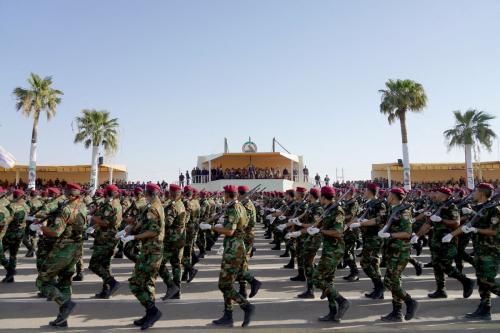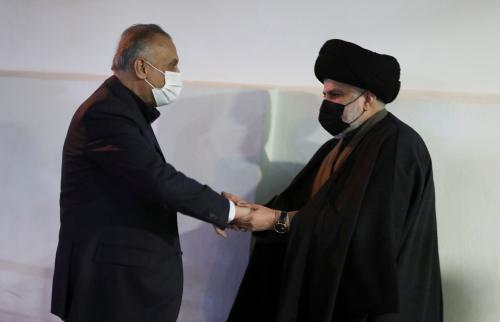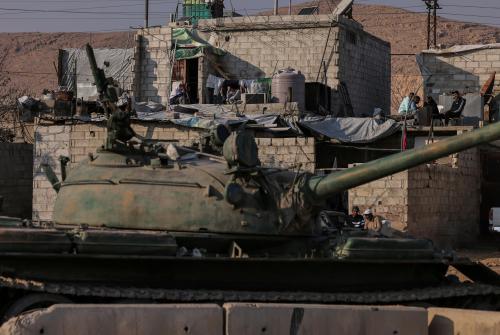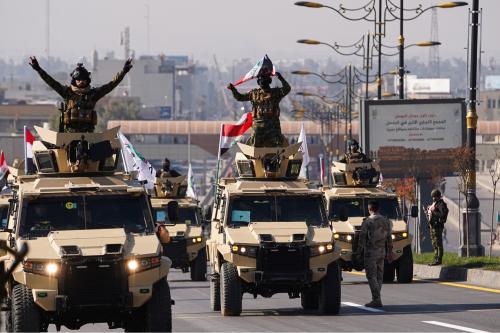Twenty years after the American-led invasion, Iraq’s seventh prime minister, Mohammad Al-Sudani, has declared corruption to be one of the biggest challenges facing the nation, describing it as “no less serious than the threat of terrorism.” Many of Iraq’s 43 million citizens agree with Sudani, as evidenced by both public opinion polling and by widespread protest movements, but few connect the crisis of corruption with the 2003 war and subsequent American occupation. Iraqis largely pin the blame on the power-sharing agreement that props up their government and on the obscenely wealthy members of the political elite.
However, Iraq’s struggle with corruption — and specifically public sector corruption — can be traced back to occupation-era reconstruction policies and to Baathist-era patronage. In reconstructing Iraq, the United States scattered unregulated and unmonitored money at many projects and, in the process, unleashed a thirst for graft and easy money at nearly every level of government, and even arguably in civil society organizations. As the Sudani administration seeks to improve public services and infrastructure to appease disillusioned citizens, it must break the patterns of post-reconstruction corruption.
Corruption and the selective distribution of public services certainly existed prior to the invasion under Saddam Hussein’s regime. In 1968, Iraq’s Baath Party gained control of Iraq through a coup, and subsequently invested heavily in public service provision fueled by oil revenues. However, the decline in oil revenue in the 1980s, the war with Iran, and economic reform measures greatly reduced the Iraqi government’s spending on public services. The 1990 Gulf War and ensuing sanctions further decimated state infrastructure, particularly the electric grid and water networks. By the end of the 90s, most Iraqi households did not have consistent access to electricity and rates of malnutrition skyrocketed, especially among children.
In these difficult circumstances, the “Oil-for-Food” program allowed for the sale of Iraqi oil in exchange for humanitarian support. The program was beset by massive fraud by Iraqi officials, international companies, and United Nations personnel. Within Iraq, Saddam and his circle reaped the majority of benefits from this program and new patterns of corruption emerged during the sanctions period. The massive rise in unemployment spurred an increase in Iraqi bureaucrats charging for access to public services during the 1990s, a pattern that continues to this day.
However, the influx of aid for reconstruction post-2003 and lack of accountability for contracting and spending brought corruption in Iraq’s public sector to new extremes. The invasion was followed by a large-scale reconstruction effort by the occupying U.S.-led coalition, the new Iraqi government, and a range of international donors. From 2003 to 2014, more than $220 billion was spent on reconstruction alone, including over $74 billion in foreign aid. In addition to violence and the exclusion of Iraqis undermining reconstruction, rebuilding efforts were hampered by massively wasteful spending and corruption at every level.
A significant number of aid project contractors, Iraqi officials, and U.S. personnel directly engaged in corruption while implementing reconstruction projects. Reports have documented cases of U.S. contractors and personnel committing outright theft of aid and implementing kickback schemes. Both international and domestic contractors were able to reap benefits from aid projects by overcharging project fees and engaging in waste and overspending. The U.S. Special Inspector General for Iraq Reconstruction report estimated that at least $8 billion of the more than $60 billion for reconstruction was outright wasted.
While gains were made in rehabilitating destroyed or deeply undermined public infrastructure, such as the health system and electric grid, they took place over far longer timelines than initially planned and at far higher costs. Instead, the postwar reconstruction funding surge reinforced the perception that aid projects specifically and public services more broadly could be sources of individual and connection-based profit with little consequence. While many cases of U.S. contractor and personnel fraud were prosecuted, many were likely not due to poor record-keeping by the U.S. government that made knowing the exact extent of fraud and waste impossible. In Iraq, anti-corruption initiatives put in place following the invasion proved to be a weak barrier against government and ministry officials protecting individuals from accountability based on sect and party membership.
Iraqi officials within the public sector widely solicited bribes in crucial sectors such as health and electricity with limited accountability from either the government or the donors bankrolling public services. While this pattern predated the invasion, it was deeply exacerbated in the post-2003 period with the influx of funding. As Iraq expert Abbas Kadhim wrote in 2010, the U.S.-backed legal system enabled sectarian parties to protect corrupt officials at every level from accountability. Violence against and assassinations of anti-corruption officials proved another deadly challenge. In 2006, for example, Deputy Minister of Health Ammar Al-Saffar was kidnapped and killed by an armed group that controlled the Ministry of Health because of an anti-corruption investigation he was heading.
Key ministries in the post-reconstruction period were staffed on the basis of political ties rather than competency. As a result, aid-funded reconstruction projects were often mismanaged once completed and handed over to the government. Even many projects highlighted as successes were found to be nonfunctional or poorly maintained due to both corruption and the exclusion of Iraqis from decisionmaking processes. Over the years, Iraq’s public sector became a tool of patronage with the increase in the number of elite civil servant positions (“special grades”) for party loyalists. This has historical roots — political science research has demonstrated that in the 1990s, individuals from Saddam’s hometown of Tikrit were employed at higher rates in the public sector compared to the rest of the population.
Twenty years after the war, public services in Iraq remain deeply damaged by patterns of elite corruption entrenched in the postwar period. A PLOS study found that of the approximately 405,000 excess deaths resulting from the war between 2003-11, a third were because of failures of infrastructure such as sanitation, transportation, and health. A recent report by Will Todman and Lubna Yousef from the Center for Strategic and International Studies highlights how political factions receive kickbacks from public electricity projects. Already-common electrical outages are worsening, and the majority of Iraqis do not have power for half of the day. According to the United Nations Children’s Fund, 3.2 million school-age children do not attend school. Iraq’s public sector was ranked as the 23rd most corrupt in the world in 2022 — an improvement from when it was tied as the second-most in 2006. The situation has prompted protests in recent years, particularly among youth frustrated with corruption’s impacts on public services and the economy.
Today, Iraq has $115 billion in foreign reserves and the Council of Ministers approved a budget (now pending parliamentary approval) of $152 billion. These are the highest numbers that Iraq has witnessed in its post-2003 history and represent an opportunity for long-term investment in the country’s infrastructure and public services. However, these numbers also risk inspiring more graft. After all, it was only a few months ago under the Kadhimi administration that $2.5 billion went missing from state-owned banks in what journalists dubbed “the heist of the century.”
What can be reasonably done to protect Iraq’s wealth for its people? Fighting corruption is both a preventive and reactive exercise, and experts have long called for redoubled efforts on anti-corruption initiatives in Iraq. Research from other contexts such as James Loxton’s study of Panama has promoted ideas including the creation of “islands of integrity” that protect key public institutions even amid broader systemic corruption. The Century Foundation’s Sajad Jiyad put forth concrete recommendations including building an anti-corruption network of civil society members and politicians and strengthening domestic institutions such as the Integrity Commission.
Other Iraq analysts have recommended transitioning the country away from a cash-based economy. The Sudani administration has started to work on this under pressure from the United States — though the United States was directly involved in setting up Iraq’s banking sector and in organizing the dollar auction that later became a money laundering vehicle for neighboring Iran and Turkey. Finally, Iraqi governments have come to view Iraq’s oil wealth as unregulated and political parties and armed groups have actively fought against any regulation. This wealth, which has been used as a tool of patronage in Baathist and post-Baathist Iraq, must be regulated by the Iraqi people if Iraq has any chance of overcoming corruption.
As the popular saying in the Arabic-speaking world goes: “loose money teaches theft.” Iraq post-2003 is a prime example of this. The long-term effects of the flood of money during the reconstruction period were to help establish the public sector as a center of corruption. Understanding the patterns of corruption entrenched during reconstruction is an important part of helping Iraq undertake much-needed public sector reform to build functioning public services for its citizens.
The Brookings Institution is committed to quality, independence, and impact.
We are supported by a diverse array of funders. In line with our values and policies, each Brookings publication represents the sole views of its author(s).



![U.S. Secretary of State Colin Powell holds up a vial that he described as one that could contain anthrax, during his presentation on [Iraq] to the U.N. Security Council, in New York February 5, 2003. [Powell tried to persuade a sceptical world that Iraq is concealing it's weapons of mass destruction and that force may be necessary to disarm it.]](https://www.brookings.edu/wp-content/uploads/2022/12/2003-02-05T120000Z_553139269_PBEAHUORSAU_RTRMADP_3_POWELL.jpg?quality=75&w=500)






Commentary
Corruption is the forgotten legacy of the Iraq invasion
April 3, 2023